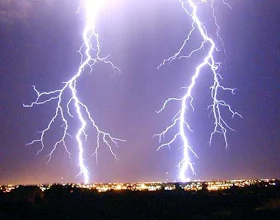Did you know that Lightning strikes are electrical discharges, which typically occur during a thunderstorms?
Did you know that an estimated 24,000 people are killed by lightning strikes around the world each year and about 240,000 are injured?

Did you know that in the U.S., between 9 and 10% of those struck by lighting die for an average of 40 to 50 deaths per year (28 people in 2008)?
Did you know that lighting in the United States, it is the #2 weather killer (second only to floods)?
Did you know that the U.S. National Park Ranger Roy Sullivan has the record for being struck by lightning the most times?
Did you know that Sullivan was struck seven times during his 35 year career?
Did you know that he lost the nail on one of his big toes, and suffered multiple injuries to the rest of his body because of the lighting strikes?.
Did you know that lightning strikes injure humans in several different ways?
- Direct strike, which is usually fatal.
- Contact injury, when the person was touching an object that was struck
- Side splash, when current jumped from a nearby object to the victim
- Ground strike, current passing from a strike through the ground into a nearby victim. A strike can cause a difference of potential in the ground (due to resistance to current in the Earth), amounting to several thousand volts per foot.
- Blast injuries, either hearing damage or blunt trauma by being thrown to the ground.
 Did you know that Telephones, modems, computers and other electronic devices can be damaged by lightning, as harmful overcurrent can reach them through the phone jack, Ethernet cable, or electricity outlet ?
Did you know that Telephones, modems, computers and other electronic devices can be damaged by lightning, as harmful overcurrent can reach them through the phone jack, Ethernet cable, or electricity outlet ?Did you know that a secondary effect of lightning on users of telephone equipment can be hearing damage, as the strike may cause bursts of extremely loud noise?
Did you know that close lighting strikes can also generate electromagnetic pulses (EMPs) - especially during 'positive' lightning discharges?
Did you know that on December 8, 1963, Pan Am Flight 214 crashed because it was struck by lighting?
Did you know that Pan Am Flight 214 loss of all 81 passengers and crew?
Did you know that LANSA Flight 508, loss 91 people – and all of its 6 crew?
Did you know that Juliane Köpcke, was the sole survivor LANSA Flight 508?
Did you know that she fell 2 miles (3 km) down into the Amazon rainforest strapped to her seat and remarkably survived the fall, and was then able to walk through the jungle for 10 days until she was rescued by local lumbermen?
Did you know that lightning rods and electrical charge dissipators, are used to prevent lightning damage and safely redirect lightning strikes?
Did you know that a lightning rod (or lightning protector) is a metal strip or rod, usually of copper or similar conductive material, used as part of lightning safety to protect tall or isolated structures (such as the roof of a building or the mast of a vessel) from lightning damage?
Did you know that lightning can strike without rain actually falling?
Did you know that if thunder can be heard at all then there is a risk of lightning?
Did you know that the safest place is inside a building or a vehicle, and that you should remains for up to 30 minutes after the last observed lightning or thunder?
Did you know that if a person is injured by lightning they do not carry an electrical charge and can be safely handled to apply first aid before emergency services arrive?
Did you know that lightning can affect the brainstem, which controls breathing?
Did you know that if a victim appears lifeless, it is important to begin artificial resuscitation immediately to prevent death by suffocation?






No comments:
Post a Comment
Thank for following